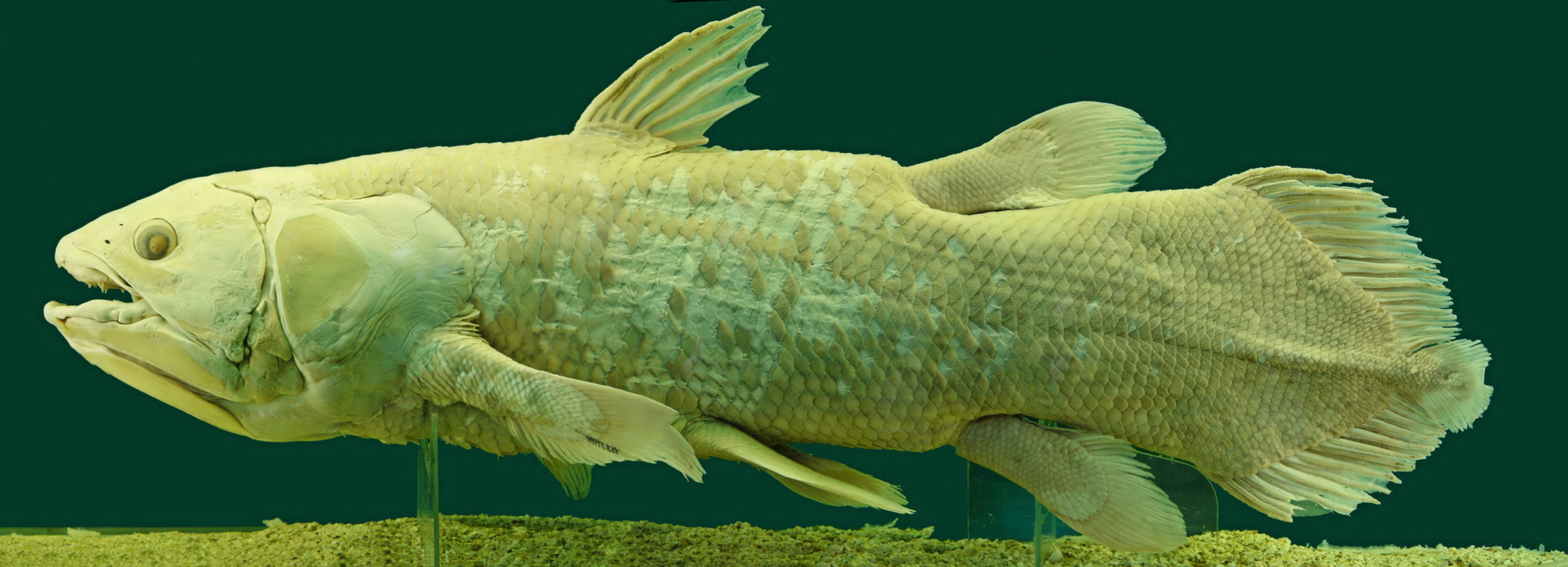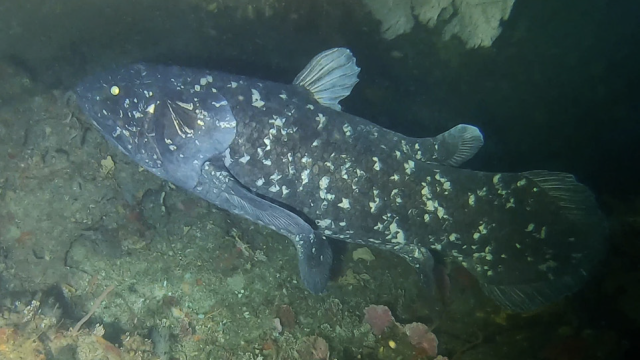An analysis of coelacanth DNA suggests its genome has experienced some significant changes in recent evolutionary history, potentially dispelling the popular image of these iconic fish as being “living fossils.”
The discovery of a live coelacanth (pronounced “see-lah-kanth”) off the coast of South Africa in 1938 was quite the shock, as these animals were believed to be extinct. The large fish were thereafter referred to as “living fossils” owing to their uncanny resemblance to near-identical species spotted in the fossil record.
New research published in Molecular Biology and Evolution presents evidence showing that at least one species of coelacanth, formally known as Latimeria chalumnae, is not the living fossil it’s presumed to be, having acquired dozens of new genes in the past 23 million years — a surprising finding, and a far cry from the idea that the species has barely changed since its ancestors emerged over 300 million years ago. What’s more, the finding is further evidence that the living fossil concept is outdated and somewhat of a misnomer.
Not much is known about coelacanths, but they’re not particularly aggressive, and they’re actually somewhat social, Isaac Yellan, the first author of the new study, explained in an email. L. chalumnae lives in the Indian Ocean and the waters off the coast of southeast Africa, and, though not extinct, the fish is elusive and critically endangered, said Yellan, a graduate student with the Department of Molecular Genetics at the University of Toronto.

Yellan and his colleagues made the discovery while doing research into proteins that bind DNA, with a focus on a protein called CGG Binding Protein 1 (CGGBP1). Other researchers have studied the function of this protein in humans, but its role in evolutionary history is poorly understood, as is its apparent similarity to a specific family of transposons — DNA sequences capable of shifting positions within a genome. This led the team to study binding proteins in other species, in a journey that eventually led them to the idiosyncratic fish.
“The African coelacanth came into the picture when we started looking for CGGBPs [DNA binding proteins) in published genomes, and found out that it has 62 CGGBP genes — way more than any other vertebrate,” explained Yellan. “We then started to look into where this large gene family might have come from.”
As noted, the 62 genes are transposons, which are often referred to as “jumping genes,” because they “jump” around the genome, but they can also make copies of themselves. Transposons are considered parasitic genes, with the sole focus of self-replication, but some transposons can influence function. So, with 62 of these genes found in coelacanths, these jumping genes are probably playing an important role.
Indeed, the new paper is highlighting the dramatic influence transposons can have on a species’ overall genome and its ongoing evolution.

Transposons are “often parasitic and can be very harmful if they disrupt genes, but they sometimes do form cooperative relationships with their hosts,” said Yellan. “There are many different ways this can occur,” he said, and a limited amount of replication can increase the host’s genetic diversity. Sometimes, however, transposons lose their ability to replicate, “which their host can then take advantage of, as is the case with CGGBP1.”
This all sounds very freaky, but basically, the host species is sometimes able to leverage the situation, in which immobile transposons are retained due to their beneficial qualities. Think of it as another mechanism for evolution, an alternate form of mutation and selection. Such appears to be the case here, with the coelacanth’s unprecedented batch of 62 transposons, which are bona fide genes derived from immobile transposons, explained Yellan.
“I’d also want to point out the transposons we studied are no longer able to jump around in the coelacanth genome,” he added. “What remain are dead ‘fossils’ of their own, and the CGGBP genes.”
The researchers aren’t entirely sure what these 62 transposons are doing, but they’re probably playing a role in gene regulation, according to the paper.
Yellan and his colleagues, including molecular geneticist Tim Hughes, also from the University of Toronto, found related genes in the genomes of other animals, but the distribution of these genes pointed to an origin outside of common ancestors.
Indeed, some but not all transposons are acquired through interactions with other species, including distantly related species, in a process known as horizontal gene transfer. The authors can’t pinpoint the exact origin of the transposons documented in L. chalumnae, but they have some ideas.
“One way that transposons can be picked up and carried between species is through a parasitic intermediary host, such as a lamprey, which feeds on the blood of fish,” said Yellan. “This is supported by the fact that we found one of these transposons in a lamprey species, although we don’t know if coelacanths received it from the lamprey, or vice-versa.”
As the new paper also points out, these genes appeared at various points during the past 22.3 million years, a figure reached through a comparative analysis of the African fish with Latimeria menadoensis, its Indonesian counterpart (the only other extant species of coelacanth), as these two species of coelacanth diverged at that time.
Which leads us to the concept of living fossils — species whose genomes have barely changed over long periods of time. Other examples include the lungfish and tuatara (an animal that resembles the ancestor of both snakes and lizards), but, as Yellan explained, the genomes of these animals, like the coelacanth, aren’t static.
“Previous research has found that while coelacanth genes have evolved slowly compared to other fish, reptiles, and mammals, its genome as a whole has not evolved abnormally slowly and is hardly inert,” said Yellan.
To which he added: “I think that as more and more genomes are being published, the ‘living fossil’ concept is becoming increasingly something of a misconception, and I think many scientists would probably hesitate to assign it to any species.”
I always liked the concept of living fossils, but I’m sufficiently persuaded that it’s a bogus concept. Sure, animals can superficially resemble their distant ancestors, but it’s the parts beneath the hood that tell the whole story.
